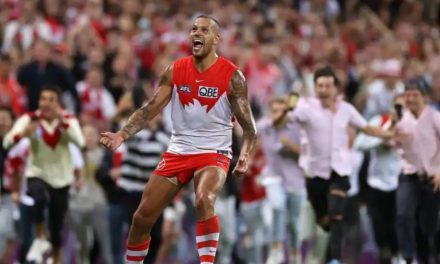Carlton skipper Patrick Cripps leads the Blues out last week against Hawthorn at the MCG. Photo: AFL MEDIA
It says something about the evenness of this AFL competition that two-thirds of the way through a season, a team which lost six games straight and eight out of nine could still be a serious finals chance.
And it also says something about what Carlton fans have been through these past couple of decades that the fact doesn’t seem to be prompting new hope, but more a sense of dread that their hearts will be broken once again.
After the ultimate letdown last year proved, the Blues residing in the top eight literally week until a Jamie Elliott goal for Collingwood knocked them out with under two minutes of the home and away season remaining, you can understand the reticence.
But here we are come Round 17, and after a winning first month of the new season then a downturn so severe Princes Park appeared to be teetering on the brink of civil war, a couple of big wins over Gold Coast and Hawthorn have Carlton ostensibly back in the ball game, a game-and-a-half outside the eight with a manageable enough draw and several rivals above it on the ladder not looking overly-convincing.
The stakes on Sunday evening in Perth against Fremantle couldn’t be much higher, and with backs to the wall, the memories of famous last-second or after-the-siren wins in the equivalent game delivered by Marc Murphy (2019) and Jack Newnes (2020) are compelling.
There’s some more tangible evidence other than just warm and fuzzy feelings, however, that Carlton supporters shouldn’t abandon all hope just yet, and it comes courtesy of stats provider Champion Data.
At the moment on the “premiership standards” chart, the Blues, whilst a dismal 14th on the AFL ladder, stand out like a sore thumb among their rivals in the lower reaches.
There are six key statistical areas in which every single premiership side of the last 10 seasons has ranked top six. And while the teams around Carlton on the ladder are almost universally ranked in the double digits for nearly all of those markers, the Blues’ numbers are in some cases far more comparable with teams in the top four.
Carlton currently ranks fourth for fewest points conceded. Every other team ranked in the top six in that category is nestled in the top eight. The Blues are ranked fourth for fewest points conceded against turnovers. And they’re No.1 for fewest opposition points from the forward half.
They’re not that shabby in a couple of other key premiership side markers, either, namely the time in forward half differential and defensive 50 to forward 50 transition. OK, so why, as I picture thousands of Carlton fans rolling their eyes, are we 14th?
PLEASE HELP US CONTINUE TO THRIVE BY BECOMING AN OFFICIAL FOOTYOLOGY PATRON. JUST CLICK THIS LINK.
The forward line, obviously, has been a problem, the Blues ranked a dismal 15th for points scored. And as much as a key target like Harry McKay wears plenty of flak about conversion, Carlton’s lack of quality small pressure forwards is pretty significant, the Blues 14th for points from turnovers and 14th for points from forward half intercepts.
But the numbers indicate strongly that there’s no underlying endemic issue which prevents the Blues performing better. It’s more a failure to “nail” all the important elements on the one afternoon or evening. Conversely, what brings Carlton unstuck one week might be different to what it causes it grief the next.
In the round 10 loss to Collingwood, the Blues had more scoring shots and broke even for inside 50s, but the Pies had their shots from more gettable range and angles, scoring 9.1 to Carlton’s 3.0 from within 30 metres of goal. The 6.15 against Sydney in Round 11 speaks for itself, this simply about kicking points instead of goals.
In the Round 12 defeat at the hands of Melbourne, the Blues, then ranked No.2 for contested ball, came up against the top team in that category and lost the count by a whopping 29, their worst result in that area yet under the coaching of Michael Voss. They also couldn’t move the ball from their defensive half forward.
Against Essendon the following week, though, Carlton had 15 more forward entries and did manage to move the ball well from its defensive 50 to the forward arc, but was brought undone this time by poor kicking efficiency, 13 per cent lower than the Bombers, the fifth biggest differential between two sides in a game this season.
And the turnaround since? Carlton smashed Gold Coast at the centre bounce, the Blues’ 50 points directly from centre bounce clearances the fourth-highest number on record.
And against the Hawks, the Blues scored 73 points from back half possession chains – their most in any game this season and only the third time in 2023 they’ve scored more than 30 points from there. Suddenly, Carlton’s ball movement and skill level seems to have come good.
The rider, of course, is that the quality of the opposition these past two wins has hardly been top notch. But bit by bit, the Blues do appear to be restoring the missing pieces of the jigsaw.
Fremantle in Perth is a tough task, the Dockers masters in the art of the “bounce back” win before an adoring home crowd. But Carlton has been here before, both literally and metaphorically. The Blues have the foundations. And how perverse it would be if, having all but burnt their supporter goodwill this season, they still had a trick or two left up their sleeve.
This article first appeared at ESPN.











